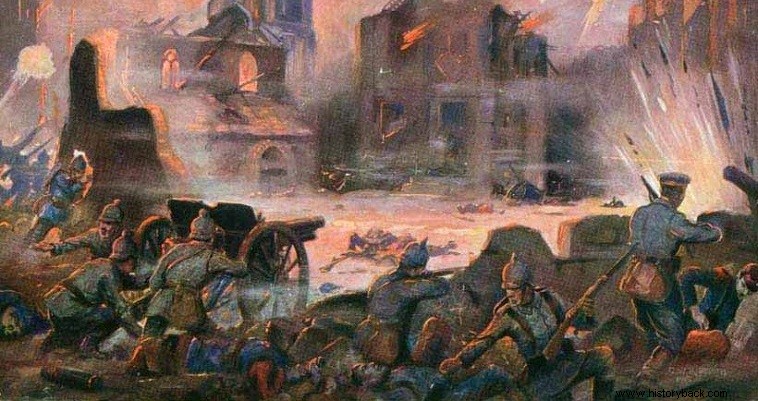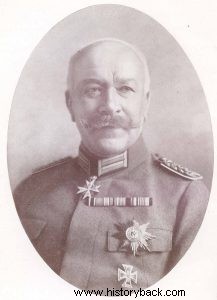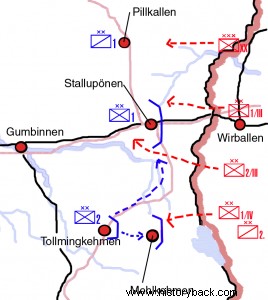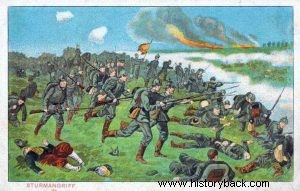
The Battle of Stalupenen, on August 17, 1914, was a foretaste of the devastating defeats the Russian army was to suffer from its German counterpart in World War I. At Stalupenen the far inferior Germans, under the all-worthy General von Francois, halted, with less than two divisions, an entire Russian army and forced it into a humiliating retreat.
On August 15, 1914, Russia and Germany were already at war. The 1st Russian Army under General Pavel Rennenkampf was preparing to invade German territory. Rennenkampf had six strong infantry divisions and five cavalry divisions.
His infantry was organized into three army corps (SS), the 10th (28th and 29th Infantry Division – MP), north, the 3rd SS (25th and 27th MP), in the center and the 4th SS (40th and 30th MP), south. The left flank of the Russian formation was covered by a cavalry division (MI) and an infantry brigade (TRI), while the other four MIs operated north of the 10th SS.
Against this force of 104 battalions and about 60 companies was only the German 1st SS under the French-born General Hermann von Francois. The 1st SS had only two MPs (24 battalions), 8 cavalry companies and 8 machine gun companies (48 elements). In terms of artillery it had 24 field artillery artillery (144 guns) and four howitzer artillery (16 howitzers). Consequently the Russians were outnumbered 4:1 in infantry and nearly 8:1 in cavalry. They also excelled in artillery.
The Russian attack
The head of the German 8th Army in charge of the defense of East Prussia, General von Priewitz, had ordered François to withdraw his forces from the border and deploy further west to the Angerap River.
Francois, however, did not obey. On the contrary, he deployed his 1st MP in Stalupenen while "spreading" his 2nd MP further south, covering a huge area of the so-called "dry land" of Rominde. The three Russian infantry SS moved from the early hours of the morning inside the German territory. However, their movement was completely uncoordinated. The 3rd SS in the center moved faster than the others and engaged the German 1st MP at Stalupenen.
The Russian 27th MP pressed the four battalions of the German 2nd MP at Goriten, southeast of Stalupenen. François hastened there at once to the most vulnerable point of the front. The southern flank of the Russian 3rd SS was theoretically covered by the Russian 4th SS. However, the 27th MP of the 3rd SS and the 40th MP of the 4th SS failed to coordinate. Thus a gap more than 10 km wide was created between them.
German counterattack
François moving towards Goritén saw a force of about regimental size, under the commander of his 2nd MP, Lieutenant General Falk , to rush towards the "sound of the guns". Indeed Falk who was in the south with most of his division, heard the noise of the battle and moved with 3+ battalions to meet the other 4 battalions of his division that were fighting at Goriten.
Arriving there he found the gap in the Russian formation and immediately attacked the exposed flank of the Russian 27th MP. At the same time, François arrived at the scene and took over the management of the match. Immediately the Germans attacked. The German surprise strike could not lack power despite the fact that the Russians were five times Falk's counterattack force.
"When the Russians they realized they were being attacked in the rear began to surrender in whole companies . About 3,000 prisoners were taken at that point alone. We could see the Russians fleeing. The battle was won," said Francois.
Further north, of course, the Russian numerical superiority had forced the Germans to retreat slightly. However, their losses were very heavy. Finally, due to the dissolution of the 27th MP, the Russians retreated altogether! Their losses exceeded 8,000 men compared to approximately 1,300 total German losses. It was a tactical triumph of reason over mass.

General von Francois. His French Huguenot ancestors had immigrated to Prussia in 1695.

Map of the battle.

